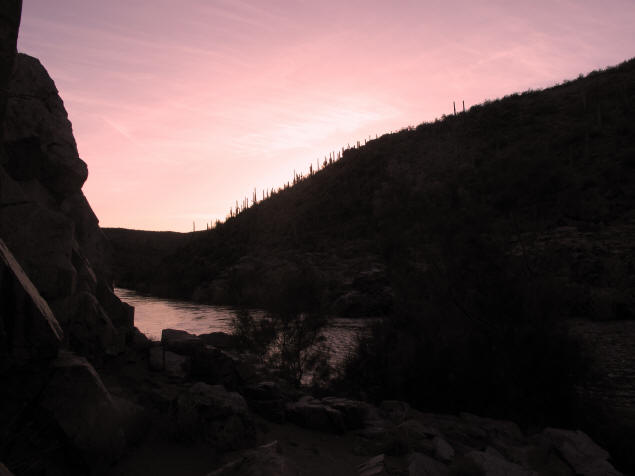| By: Paul S. Cilwa | Viewed: 5/18/2024 Posted: 5/8/2010 |
Page Views: 1446 | |
| Topics: #UpperSaltRiver #Arizona #WhitewaterRafting #WildernessAware | |||
| I spend the first of two days rafting the Upper Salt River. | |||
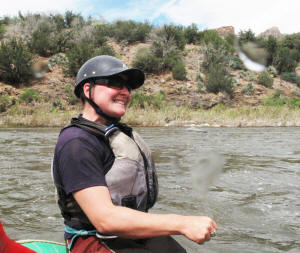
By the time the lecture was over, Boatman Liz was ready for us. We got fitted into life vests (excuse me, "personal floatation devices"), helmets, and were handed paddles. We got into the "guest raft" (as opposed to the baggage boat) and took positions, pretty much by whim though Boatman Liz warned she would probably reposition some of us to balance our the relative strength of left and right sides, later.
By the way, if you're wondering why female river guides are called "boatmen" just like male guides, so was I years ago when I asked Annie Anderson, a guide in Grand Canyon, that very question. "I like 'boatman'," she replied. "I worked very hard to become one and I'm proud of it. Besides, 'Boat Woman' sounds like the name of a superhero, and 'boat person' has been taken (by refugees from Cuba and Southeast Asia, in the news at that time)".
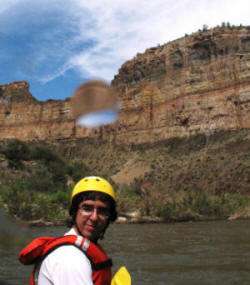
I had my Canon Powershot G10 in the waterproof plastic bag I bought last year for the Alaska rafting trip. The clear lens cap almost immediately became covered with drops of water, without my knowing it. So, as we made our way downriver, most of the resulting pictures featured water drops.

Boatman Liz, as is customary, taught us the commands she would be issuing (Forward, Back Paddle, Left Back, Right Back). Everyone either had already been rafting at least once, or was a quick study. Both she and I were amazed at how well our team performed as a, well, team. Usually it takes hours before everyone synchronizes and sometimes, especially on a 1-day trip, it never really happens. But it was clear from the outset that we would be able to respond to Liz' commands quickly and effectively; and, therefore, if we flipped the boat it would be her fault!
This was a "paddle boat", meaning all the passengers would sit on the sides and paddle. In fact, we are called "guests" rather than "passengers" because of our active role. We sat across from each other in 4 rows. From front to back that made us (after Boatman Liz' final adjustments):
| Left | Right |
|---|---|
| Justin | Lauren |
| Liz | Angel |
| Tabbatha | Me |
| Boatman Liz | Anika |
Because of my tendency to photograph more in front of me, the people sticking their heads in front of most of the pictures that follow will be Justin, Liz, and Angel. I assure everyone, I wasn't trying to leave anyone out!
Some people, possibly most people, go on whitewater rafting trips to experience the thrill of the whitewater. I'm more about the river experience: Getting away from civilization and artificial noises, to where I can hear the birds and see the stars and enjoy untrammeled nature. I enjoy the whitewater, of course; but even more I appreciate the slow unfolding of scenery as the raft travels down one river corridor and then another. Each part of a canyon is unique and a thousand photographs would be too few to do it justice.
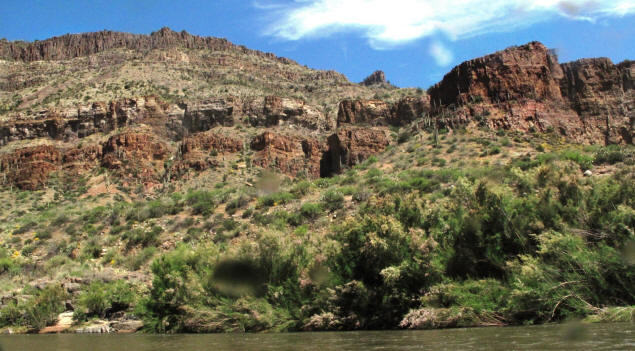
As we paddled and floated, Boatman Liz asked us about ourselves. As I mentioned, Anika, Tabbatha and Angel were war widows. Each one had been married to a serviceman who had been killed: two in battle, one in a senseless car accident while stationed in Germany. All were young, and their husbands had been far too young to have their lives cut so short. They were all members of an online group for women in similar straits, The American Widow Project, which provides support and a way for such women to make friends with each other and get help in healing.
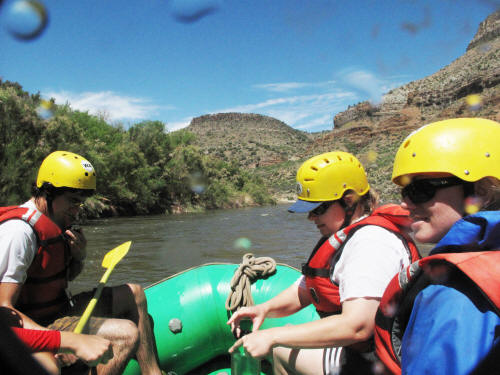
Justin, Liz and Lauren were graduate students in various disciplines. Justin is studying fish biology; Lauren and Liz are becoming archaeologists. On learning this, Boatman Liz of course had to ask them questions she had about the biology and history of the canyon. However, since their doctorates were in specialties unrelated to the area, none of them could be of much help. We did, however, learn from Justin that the Salt River is home to the Colorado Pikeminnow, which grows to be an amazingsix feet long! That's some minnow!
Presently we came upon the Apache Salt Bank. The section of the bank is sacred to the White Mountain Apache people, along whose reservation the river runs. (The San Carlos Apache reservation runs along the other bank.) Rafters are forbidden to touch the salt bank or land on the north shore for several miles starting at the point. The bank is located in a grotto carved out of the bank, where streamers of salt-laden water trickle down the walls, leaving precipitated sodium chloride (table salt) behind.
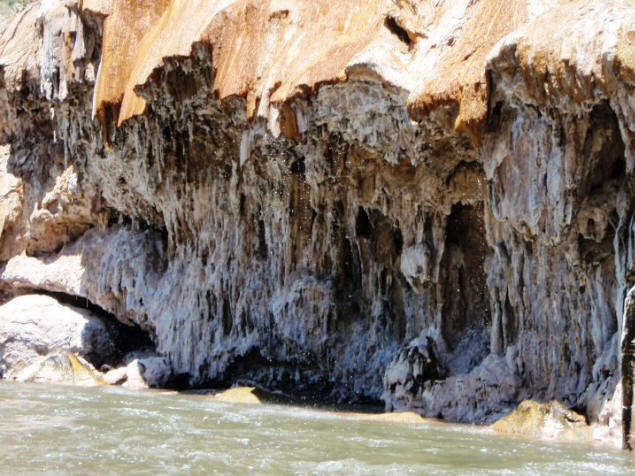
The morning was absolutely exquisite, warm enough that the occasional splashes didn't chill, yet not too hot. Wispy ice clouds far overhead didn't detract from the intense blue of the sky; indeed, they accented it.
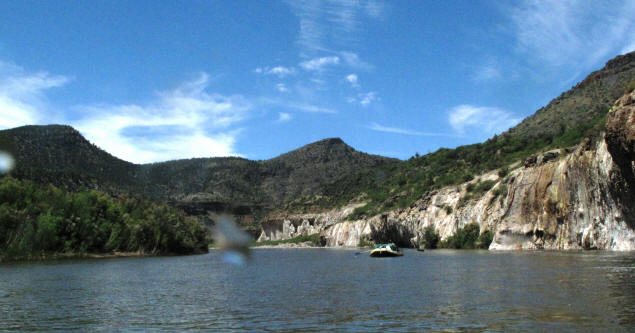
Lunchtime came and we moored the two boats at a place called Top of White Rocks, then relaxed while Glenn and Boatman Liz prepared lunch.
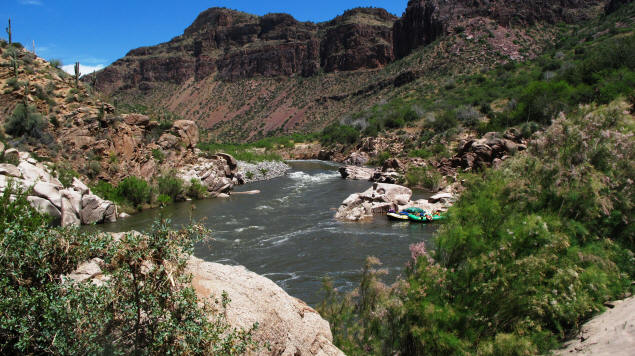
The war widows asked me to shoot a photo of them, which I happily did. In return, they took one of me.
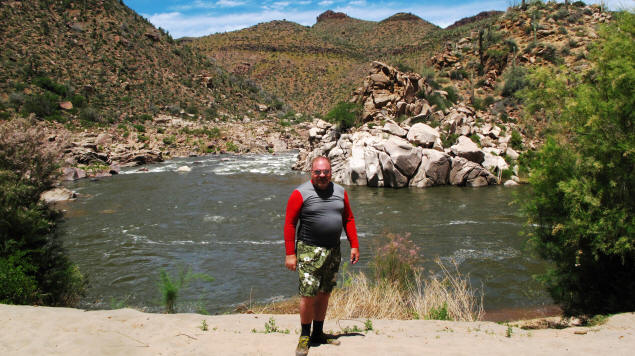
Lunch consisted of tortillas filled with chicken salad plus various condiments. It was simple but filling, and tasted good. We refilled our water bottles with our choice of very intense lemonade, or water. (I went for both, half-and-half.) Glenn and Boatman Liz repacked the baggage boat, and we were on our way.
This area was known as White Rock Canyon, where granite from ancient volcanic activity stills holds its melted shape.
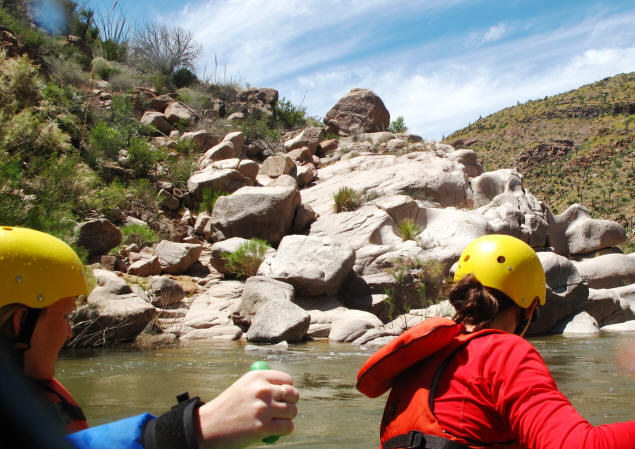
A wind came up, as is common these parts in the afternoon as the distant city of Phoenix heats up and the warmer air rises up into the hills and winds through the canyons. Since the wind came from downstream, we had to paddle to overcome it. But that didn't stop us from enjoying the glorious vistas and geologic marvels as we made our way downstream.
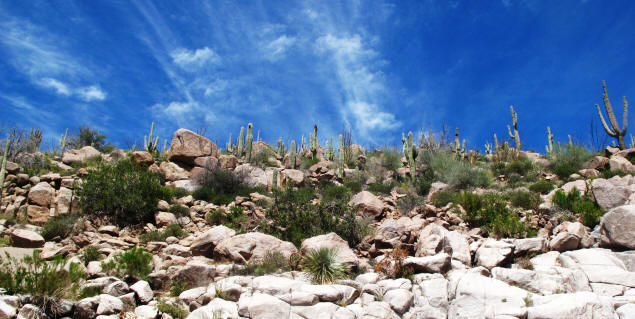
Rivers flow downhill, of course; we were losing elevation with every mile, thus getting to warmer climates. The appearance of stately saguaros, Arizona's official State Tree, signaled our entrance into the Sonoran Desert.
We then came upon a giant block, about 50 feet high, easy to climb and (relatively) safe to jump from. Since my last two leaps have ended disastrously, I elected to stay behind and photograph the jumpers.
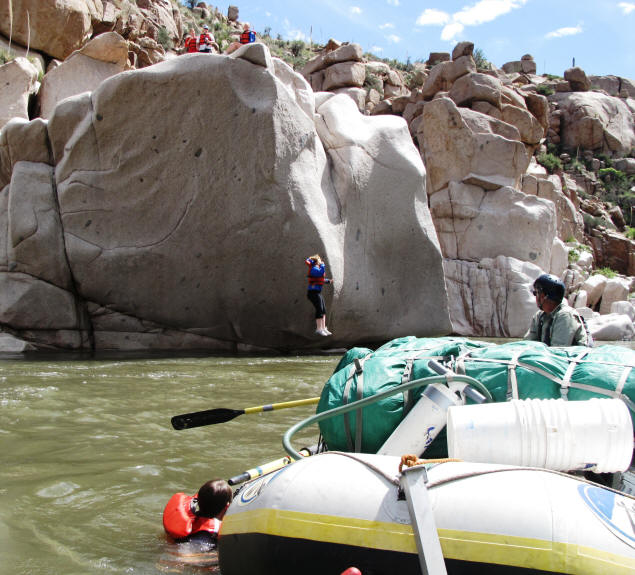
Boatman Liz saved a Class III rapid for me to photograph while the others paddled.
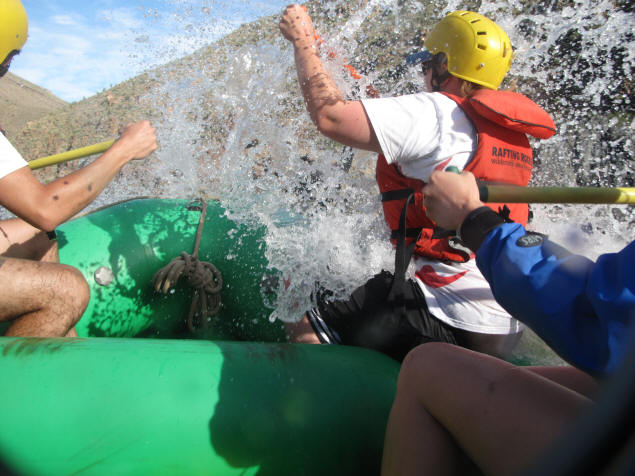

Mid-afternoon, as we quietly drifted past an area known to be a bald eagle habitat, Boatman Liz suddenly gasped. Most of the time, she explained later, one never actually sees an eagle, even though they nest there. But today, a majestic eagle swooped down from the sky and calmly perched on a rock, and stayed there—posing for a picture. I frantically tried to get my camera adjusted before the bird flew away—and I took a shot, but as fate would have it, a water drop precisely obscured the eagle. Fortunately, Justin was able to get (and later share) a terrific picture.
Around five o'clock—I didn't bring a timepiece—we stopped at a place called Yankee Joe to make camp for the night. We all assisted in unloading the Pig (what Glenn called the baggage boat) and then set up our tents.
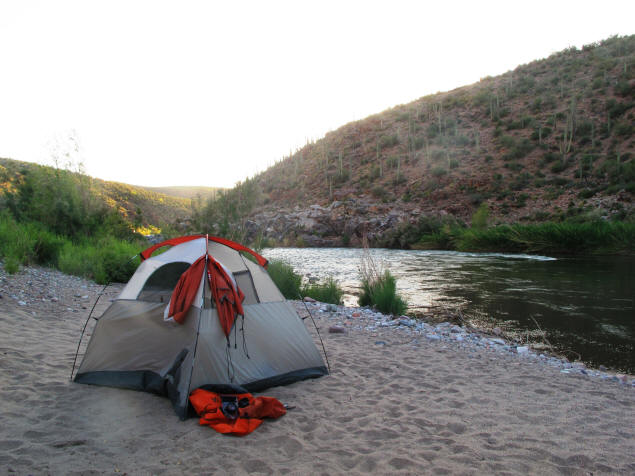
There was a section set off by great, marble blocks, that was used for our bathroom. It even had a foyer!
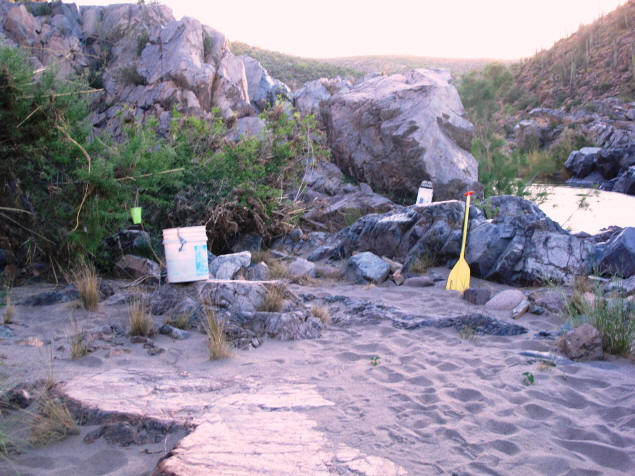
The paddle is an indicated that the toilet, hidden around the corner, is not in use. When you come to use it, you bring the paddle with you. If someone else comes and doesn't see the paddle, they know to wait. The white bucket contains clean water. When you return, you take the little cup, fill it with water from the bucket, and hang it back on the tree branch. The cup has a hole in the bottom, so water dribbles out allowing you to wash and rinse your hands (soap is also provided).
The toilet itself, located around the corner, is actually a lined ammunition case with a fitted toilet seat.
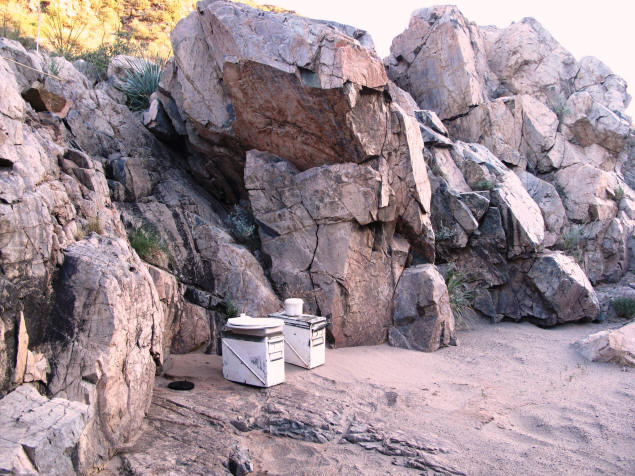
When they first started using ammo boxes to pack human waste out of these pristine areas, back in the '70s, it didn't occur to anyone to add a toilet seat. After sitting for a few minutes, people would rise with two deep grooves inscribed along their butts. The toilet seat prevents that effect, thank the gods; but these toilet facilities are still called "groovers".
Glenn and Boatman Liz prepared an excellent dinner of T-bone steaks and chicken, corn-on-the-cob, new potatoes with garlic and herbs, plus a fresh salad. And they made brownies in a Dutch over for desert!
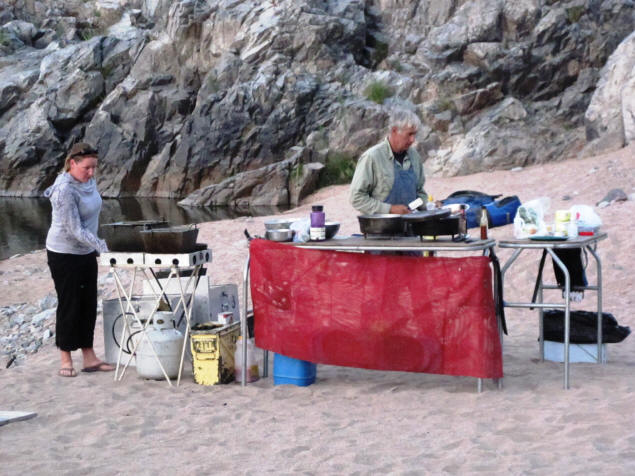
We ate in camp chairs previously set up…we didn't even have to do that.
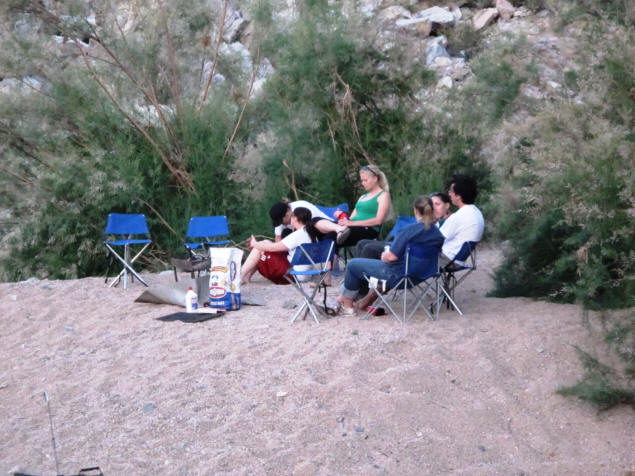
Soon the sun set. We remained in the chairs for awhile, talking. The widows shared some of their stories; the students talked about their school experiences and plans for the future. I mostly listened. At one point, I overheard the words, "I don't believe in aliens." Normally, I would have been all over that topic. But, to my surprise, I felt no urge to reveal my own experiences in that regard. In fact, I was pretty tired.
My arm, healing from a torn muscle suffered in Hawaii a couple of weeks ago, was doing really well. Despite paddling all day, it actually felt better than it had that morning. The exercise had done it good. But I was really, really, sleepy. I took one last look at the darkening sky and emerging stars, crawled into my tent, and fell into a deep sleep.
